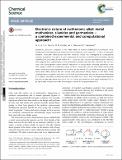Electronic nature of zwitterionic alkali metal methanides, silanides and germanides - a combined experimental and computational approach
Date
01/02/2017Metadata
Show full item recordAbstract
Zwitterionic group 14 complexes of the alkali metals of formula [C(SiMe2OCH2CH2OMe)3M], (M- 1 ), [Si(SiMe2OCH2CH2OMe)3M], (M- 2 ), [Ge(SiMe2OCH2CH2OMe)3M], (M- 3 ), where M = Li, Na or K, have been prepared, structurally characterized and their electronic nature was investigated by computational methods. Zwitterions M- 2 and M- 3 were synthesized via reactions of [Si(SiMe2OCH2CH2OMe)4] ( 2 ) and [Ge(SiMe2OCH2CH2OMe)4] ( 3 ) with MOBut (M = Li, Na or K), resp., in almost quantitative yields, while M- 1 were prepared from deprotonation of [HC(SiMe2OCH2CH2OMe)3] (1) with LiBut, NaCH2Ph and KCH2Ph, resp. X-ray crystallographic studies and DFT calculations in the gas-phase, including calculations of the NPA charges confirm the zwitterionic nature of these compounds, with the alkali metal cations being rigidly locked and charge separated from the anion by the internal OCH2CH2OMe donor groups. Natural bond orbital (NBO) analysis and the second order perturbation theory analysis of the NBOs reveal significant hyperconjugative interactions in M- 1 -M- 3 , primarily between the lone pair and the antibonding Si-O orbitals, the extent of which decreases in the order M- 1 > M- 2 > M- 3 . The experimental basicities and the calculated gas-phase basicities of M- 1 -M- 3 reveal the zwitterionic alkali metal methanides M- 1 to be significantly stronger bases than the analogous silanides M- 2 and germanium M- 3 .
Citation
Li , H , Aquino , A J A , Cordes , D B , Hase , W L & Krempner , C 2017 , ' Electronic nature of zwitterionic alkali metal methanides, silanides and germanides - a combined experimental and computational approach ' , Chemical Science , vol. 8 , no. 2 , pp. 1316-1328 . https://doi.org/10.1039/C6SC02390H
Publication
Chemical Science
Status
Peer reviewed
ISSN
2041-6520Type
Journal article
Rights
© 2016 The Authors. Open Access article. This article is licensed under a Creative Commons Attribution 3.0 Unported Licence.
Description
This project was funded in part by the NSF (grant no. 1407681; Project SusChEM: IUPAC) as part of the IUPAC International Funding Call on “Novel Molecular and Supramolecular Theory and Synthesis Approaches for Sustainable Catalysis”. Support was also provided by the TTU Department of Chemistry & Biochemistry cluster Robinson whose purchase was funded by the NSF (CRIF-MU CHE-0840493).Collections
Items in the St Andrews Research Repository are protected by copyright, with all rights reserved, unless otherwise indicated.

